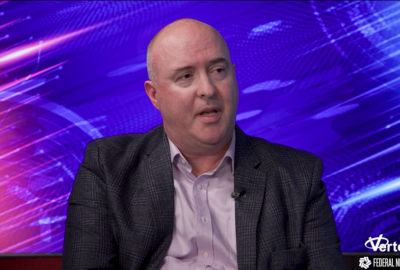
Insight by ThunderCat Technology and Dell Technologies
Industry Exchange Data 2023: Effective AI requires ‘Goldilocks’ mix of data, people and process
What’s “explainable AI,” and why is it desirable? In this discussion with experts from ThunderCat Technology and Dell Technologies, learn the answers and ...
Advances in algorithms have brought the application of artificial intelligence and machine learning to an inflection point. Now, organizations can meet some of their most critical information needs in an automated fashion with a combination of the right data, AI applications and support infrastructure.
Federal agencies in particular can improve the efficiency of services in a profound way, said Kurt Steege, chief technology officer at ThunderCat Technology. Agencies can also “reduce costs, and have employees focus on the tasks that are that are really important for the job,” he said during Federal News Network’s Industry Exchange Data.
Perhaps the most important benefit from AI is that it enables people to extract an essential fact or pattern from datasets too large to otherwise comprehend, added Art Villanueva, chief AI/ML technology architect for federal strategic programs at Dell Technologies.
And agencies don’t have to look far for use cases. Many fall under the general theme of predictive analytics or “trying to understand what’s going to happen in the future,” Villanueva said. “Predictive analytics allows you to do that, using all the billions and maybe trillions of data points and being able to sort through that.”
He said that even when used for fraud detection, typically an after-the-fact discovery, agencies can gain predictive ability with AI. In cybersecurity, “there is protecting not just against known threats but also protecting against threats that we have not seen yet, but our AI and machine learning are able to detect.”
Among the top challenges to effective AI/ML use, selection and subsequent handling of data sit at the top of the list.
“It’s just the beginning, knowing where it is, finding data,” Steege said. Equally important is enriching data with metadata — so multiple applications can use it — and ensuring data is in the right format, he added.
Expanding use of AI hinges on expanding talent pools
Steege sees human capital as another major challenge to expanding the use of AI/ML.
“The the amount of highly skilled professionals is quite low,” he said. “They’re desperately needed. But it’s more than just a volume perspective. It’s also a diversity perspective that needs to be addressed.”
Diversity can help keep biases from getting into AI applications in training data, for example. But diversity also means technical diversity. He cited a generative AI platform that kept turning out code for a cybersecurity application in Visual Studio code. The programmer had to specify to the platform that he needed Python.
Plus, agencies need people who simply think differently, Steege said. For instance, while looking for relationships in social media using a triangulation technique, a high school intern suggested looking in a linear fashion, which resulted in a 10-fold yield in relationship discovery, he recounted.
The right data, people and algorithms lead to still another challenging requirement, namely transparency, Villanueva said.
“Transparency needs to be at the forefront,” he said. Without transparency, or what he termed “explainable AI,” people for whom agencies deploy AI simply won’t trust the technology.
Explainable AI means an application produces information about how it arrived at a particular solution or answer to a problem — “transparently from the beginning, where it got all the data” through the entire process used to reach decisions or outcomes, Villanueva said
Addressing the government’s biggest challenges
Despite the challenges, the federal government has a pressing need to deploy AI technology, both experts agreed.
Steege pointed to the U.S. Patent and Trademark Office as an example. The number of incoming patent applications is accelerating. It took from the founding of the republic to 2018 to reach 10 million patents. In the last three years, PTO has amassed 3 million more applications. Without AI/ML-powered help, there’s no way examiners can do a complete search for prior art to reach a fair decision, he said.
“Everybody will be affected by AI and ML,” Villanueva said.
Check out all the sessions from Federal News Network’s Industry Exchange data on our event page.
Copyright © 2024 Federal News Network. All rights reserved. This website is not intended for users located within the European Economic Area.
Related Stories

Protected: Intelligent automation and cloud marketplaces help agencies optimize cost and speed cloud adoption

All agencies to give grant funding opportunities a facelift
Featured speakers
-

Kurt Steege
Chief Technology Officer, ThunderCat Technology
-

Art Villanueva
Chief AI/ML Technology Architect for Federal Strategic Programs, Dell Technologies
-

Tom Temin
Host, The Federal Drive, Federal News Network
Upcoming Events
Related Stories
Top Stories

Kurt Steege
Chief Technology Officer, ThunderCat Technology
Kurt Steege is the Chief Technology Officer at ThunderCat Technology, a Service-Disabled, Veteran-Owned Small Business that delivers technology services and solutions to the federal government and Fortune 500 companies. At ThunderCat he is responsible for driving technology value for our clients through evaluation, architecture, and outreach.
Prior to joining ThunderCat, Kurt was the Chief Information Officer of MacAndrews and Forbes Inc., a diverse global holding company, based in New York City. During his time there he led a complete IT transformation and brought the company a modern standardized infrastructure upon which the business can depend. In the government space, Kurt served as the Chief Enterprise Architect at the FBI. Under Kurt’s leadership at the FBI the EAPO created roadmaps for IT Transformation, strategic direction for Shared Services, Mobility, Storage, and User Experience.
Over the rest of his 20+ year career in Information Technology, Kurt has held roles within private industries for technology, financials, and education to help drive value and efficiency into small, medium and large organizations.

Art Villanueva
Chief AI/ML Technology Architect for Federal Strategic Programs, Dell Technologies
Art Villanueva is the AI/ML Chief Technology Architect for Dell Technologies’ Federal Strategic Programs. In the past, he has served as lead systems engineer for multiple high-profile programs, including billion-dollar initiatives. Art is an entrepreneur, having founded two renewable energy startups, one of which is now trading on the NASDAQ stock market; and an inventor with three patents. He is also a Doctor of Engineering candidate in Systems Engineering at Colorado State University, specializing in meta-algorithmics applied to document automation and natural language processing. He obtained his master's degree in Architecture-based Enterprise Systems Engineering from UCSD and his bachelor's degree in Applied Mathematics with a Specialization in Computing from UCLA.

Tom Temin
Host, The Federal Drive, Federal News Network
Tom Temin has been the host of the Federal Drive since 2006 and has been reporting on technology markets for more than 30 years. Prior to joining Federal News Network, Tom was a long-serving editor-in-chief of Government Computer News and Washington Technology magazines. Tom also contributes a regular column on government information technology.



